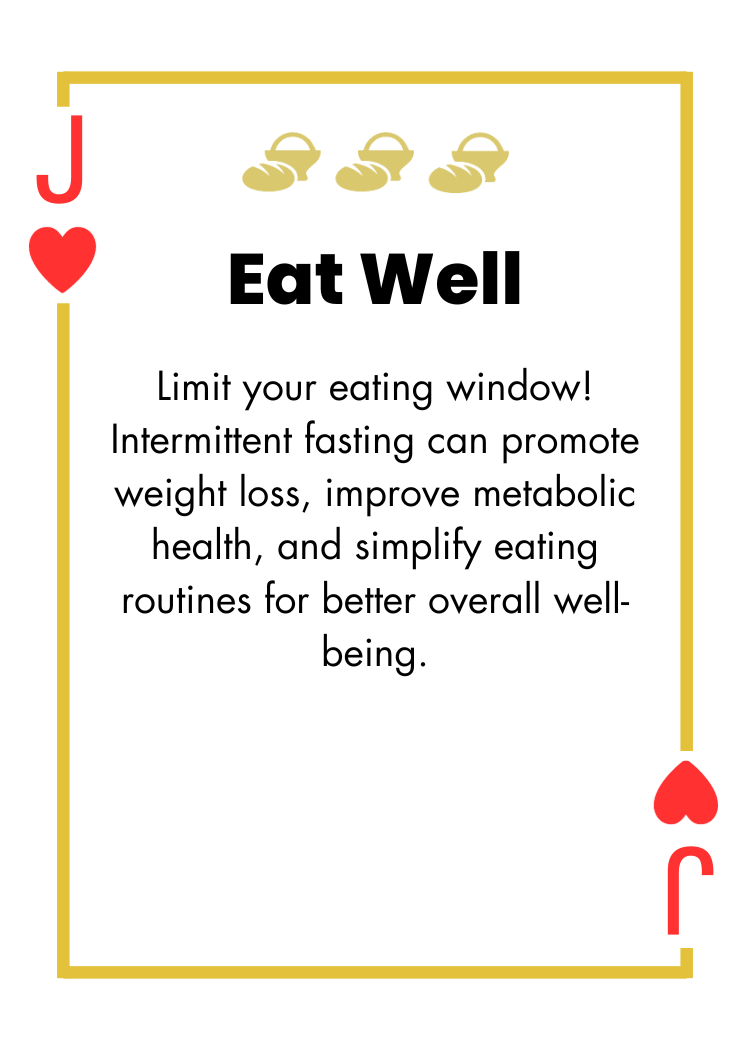Jack of Hearts - Intermittent Fasting

Intermittent fasting is defined as eating within a certain time range or alternating fasting for an entire day with a feasting day or days. For example, intermittent fasting may be characterised as eating foods within an 8-hour period but fasting for the remaining 16-hour period (Volpe 2019).

Intermittent fasting diets have gained in popularity in recent years since they can produce clinically significant weight loss. These diets consist of periods of fasting alternating with periods of eating. The most investigated types of intermittent fasting include alternate day fasting marked by a 0–500 kcal per fast day alternating with the intake of food freely on feast days.
Next, the 5:2 diet consists of two fasting days interspersed with five feast days per week. Finally, time-restricted eating is based on eating within a prescribed window of time each day (Varady et al., 2022).
Before making any major changes in your diet, ensure you first consult with a qualified Dietitian, nutritionist or physician. This applies especially to individuals with diabetes or other cardiometabolic conditions.
Intermittent fasting is largely safe and produces limited gastrointestinal, neurological, hormonal, or metabolic adverse effects (Varady et al., 2022).
The three main forms of intermittent fasting which include alternate day fasting, the 5:2 diet and time-restricted eating produce mild to moderate weight loss with approximately 3 to 8 percent loss from baseline over short durations of 8–12 weeks (Varady et al., 2022). The extent of weight loss achieved with intermittent fasting is on the same level as weight loss achieved using traditional dieting approaches based on daily calorie restriction (Varady et al., 2022). A few research studies demonstrate how intermittent fasting improves cardiometabolic risk factors such as blood pressure, levels of LDL cholesterol and triglycerides, insulin resistance and HbA1c (Varady et al., 2022).
In a systematic review of intermittent fasting and weight loss, Welton et al. (2020) found in all 27 trials examined in the review, intermittent fasting resulted in weight loss and ranged from 0.8% to 13.0% of baseline body weight. Weight loss occurred regardless of changes in overall caloric intake. Additionally, the authors found in the studies lasting 2 to 12 weeks in duration, on average body mass index decreased by 4.3% to a median of 33.2 kg/m2. Lastly, symptoms such as hunger remained stable or decreased, and no adverse events were reported.
Based on the research available, intermittent fasting seems to be beneficial, not only to weight loss but with respect to cardiometabolic risk (Volpe 2019).
Research is still being undertaken as to whether these methods are sustainable over a long period of time.
Check-in with our expert nutrition coaches to see if intermittent fasting might be for you. All our nutrition experts are Dietitians, so they know their stuff!
Small changes CAN make a big difference. That’s what The 1% Club is all about.
Varady, K. A., Cienfuegos, S., Ezpeleta, M., & Gabel, K. (2022). Clinical application of intermittent fasting for weight loss: progress and future directions. Nature reviews. Endocrinology, 18(5), 309–321. https://doi.org/10.1038/s41574-022-00638-x
Volpe, S. L. (2019). Intermittent fasting- What is it and does it work? ACSM’s Health & Fitness Journal 23(1) 34-36, https://doi.org/10.1249/FIT.0000000000000444
Welton, S., Minty, R., O’Driscoll, T., Willms, H., Poirier, D., Madden, S., & Kelly, L. (2020). Intermittent fasting and weight loss: Systematic review. Canadian Family Physician, 66(2), 117-125.


 See Other Cards!
See Other Cards!